John Asks: Why is Josou Shounen Becoming a Mainstream Trend?
Question:
Following the announcement of the Mayoelle Otokonoko anime about crossdressing boys, I started to wonder to myself what the root of this emerging trend is.
Crossdressing is a historical and cultural tradition in Japan. Male actors have played female roles in Noh dramas since the 1300s. The onnagata male actor playing a female character in kabuki stage plays first appeared in 1629. The “swinging sixties” brought crossdressing out of the theater and into the Japanese underground social scene, as documented by director Toshio Matsumoto’s 1969 motion picture Funeral Parade of Roses. In anime female characters that dress and act like men date back to 1967’s Ribon no Kishi and 1979’s Rose of Versailles. But crossdressing male characters have a different and seemingly presently evolving history in anime. Particularly over the past three or four years the Japanese otaku community has developed an increasing fascination with josou shonen or otokonoko characters – young, effeminate boys who dress as girls. Personally, I have little interest in this phenomenon, but I am highly curious about the fascination itself, particularly what motivates the interest.
The 1983 television series Stop!! Hibari-kun! revolved around Hibari Oozora, a high school boy who preferred to dress, act, and be perceived as a girl. This series was primarily a situational comedy. The 1987 Oira Sukeban (“Delinquent in Drag”) OVA stared a crossdressing boy but made fun of the situation rather than fetishizing it. Aoi Futaba of the 1996 You’re Under Arrest television series willfully crossdresses, but isn’t a focal character. The 2001 television series I, My, Me! Strawberry Egg starred a crossdressing young man, but again the show made fun of the situation and didn’t fetishize its crossdessing star. However, a new wave of crossdressing anime boys appeared in 2006. That year the Princess Princess television series featured three school boys who dress as girls, but the anime is primarily targeted at female viewers. The star of the 2006 Otome wa Boku ni Koishiteru television series also crossdressed as a girl, but did so somewhat unwillingly. That same year, though, introduced the Happiness! television series, a program for male viewers in which character Jun Watarase became popular because he dressed and acted like a girl. The shota erotica OVA Boku no Pico also premiered in 2006 and featured an effeminate boy easily convinced to wear girls’ clothing.
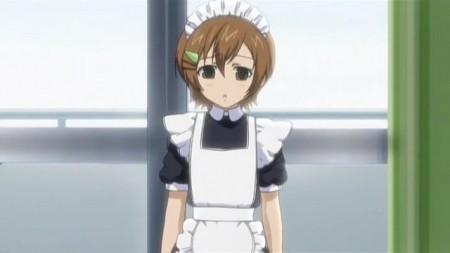
Since 2006 a sizeable number of anime productions targeted at male viewers have prominently featured crossdressing boys. Examples include H2O: Footprints in the Sand, Mariaholic, Baka to Test to Shokanjuu, Seikon no Qwaser, Okami-san to Shichinin no Nakama-tachi, Shounen Maid Kuro-kun, Minami-ke, Black Lagoon, Working, Kamen no Maid Guy, and the upcoming Mayoelle Otokonoko. Although not strictly crossdressing, the Kashimashi (2006) and Kampfer (2009) anime series revolve around boys physically transformed into girls. Unlike the earlier, well known Ranma 1/2, in which Ranma Saotome’s transformation was superficial, Kashimashi and Kampfer somewhat fetishize the character of a boy within a girl’s body. (Granted, the 1987 erotic OVA Body Jack did that too, but the emphasis in Body Jack was on the experience, not the character.) The 2008 Macross F television series is also worth mention because it’s a program targeted at male viewers in which the male protagonist is nicknamed “Princess” because even other boys recognize his feminine attractiveness. On a related side note, fan art depicting male characters crossdressing has exploded since 2006. Manga anthologies and magazines catering to the fetish including Otokonoko Heaven, Shounen Shikou, and WAai! Boys in Skirts have launched since 2006 (actually, 2005; it’s natural that shota & yaoi manga would have provided the beginings of this new trend). And crossdressing maid cafés including Hibari-kei and New Type have opened. Clearly, the era of male otaku fascinated by boys wearing girls clothing has sprung up since 2006.
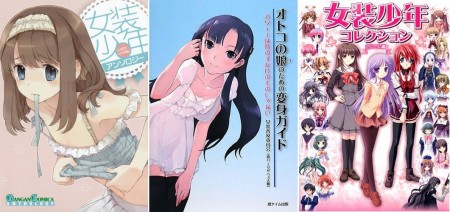
So why have Japanese boys suddenly become so fascinated with boys dressed as girls? Japanese crossdressing expert Junko Mitsuhashi cites the revival of crossdressing in Japan as a return of a repressed tradition which has always been present in Japanese society. My personal theory is that this new otaku fascination may also be an outgrowth of the contemporary moé phenomenon. The fascination with innocent cute little girls has merged with the larger Japanese fascination with cuteness and evolved into an interest in cute, effiminate characters regardless of underlying gender. Particularly in Baka to Test to Shokanjuu, for example, the boys are more infatuated with the effeminate boy Hideyoshi Kinoshita than his twin sister or the cast’s two prominent girls. Girls Minami Shimada and Yuko Kinoshita are more masculine than the boy Hideyoshi, and Mizuki Himeji’s large bust and awful cooking make her a less appealing girl than the “underdeveloped” and highly feminine boy Hideyoshi.
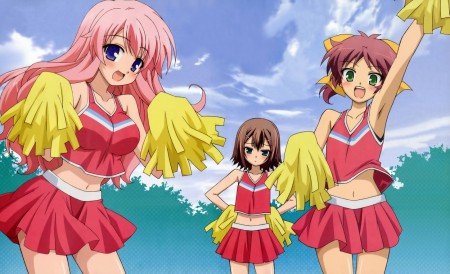
Within a somewhat socially repressive environment, in which citizens are expected to conform and contribute to the social good, anime is a temporary escape from reality and crossdressing serves as an outlet for personal expression. Dressing as a girl allows Japanese boys and men (such as Haruhi Fujioka’s crossdressing father in Ouran High School Host Club and the countless “okama” in One Piece) to not just express their softer, feminine side, but to temporarily drop their burden of male responsibility. Attraction to these characters may also be tied to a sense of ease. Male viewers that like josou shounen characters may feel more comfortable relating to a boy that looks like a girl than an actual girl because jousou shonen anime characters consistently seem more compassionate, receptive, and considerate than female anime characters that expect normal boys to act like boys. Josou shounen themselves don’t look or act like boys and don’t demand that other boys live up to the stereotypical male characteristics that girls expect. So setting aside preoccupation with gender, josou shounen anime characters are typically even more feminine and approachable than actual girl characters are. The argument may be made, in this case, that cute is cute, regardless of gender. But if that’s the case, why would heterosexual otaku supplement or even supplant attraction to female characters with josou shounen characters? Some otaku may be partially shifting their interest in cute anime girls onto cute anime boys that look like girls because the later provide the same opportunity for moé obsession without the need to respect conventional masculine and feminine gender roles.
Add a Comment
You must be logged in to post a comment.
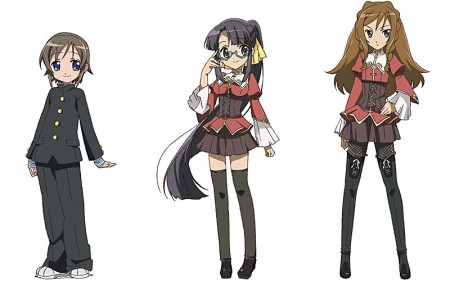
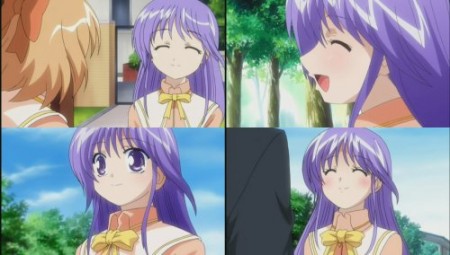


I read long ago that it’s quite common at Japanese anime conventions for boys to dress as attractive girls and for male fans to take sexy pictures of them in provocative poses. So the origins of this trend probably goes back -way- before just 2006.
Also, don’t forger the popularity of female actresses played by males in kabuki theatre which extends for many centuries. That could also explain the sexual attraction to crossdressers in Japan, in addition to the face that sexuality there is sometimes more defined by a person’s actions than the gender of who they like.
Certainly, there’s no question that male crossdressing has been present in Japan’s otaku community for a long time. It just seems like it’s prominently invaded mainstream television anime since 2006.
I see that as a sign of weakness and/or mental illness. Boys nowdays can’t tolerate the burdain that means be a REAL man, so they want to be little girls.
Thanks for the good history lesson, John. There’s nothing wrong with changing up one’s attire and starting up a club to have a good time.
I thought KASHIMASHI was a pretty solid anime, it’s a very sweet title, though a bit imperfect/impractical in its execution at times. But on the whole, I think the series did the subject matter justice.
Kyouki, if you were a real man then you’d be more comfortable with your masculinity and wouldn’t feel to lash out at others in a homophobic manner.
So what if someone chooses to cd or be gay or whatever? It has no bearing on my life or yours. It’s their choice and it doesn’t harm anyone whatsoever. A lot of these desires and interests for people are largely genetic and beyond their control. They’re not weak or “mentally ill”, that’s just who they are.
Kyouki: It takes a lot more strength of character to stand out and be different when it comes to something like being transgendered or homosexual than it does to just cave to the pressure society puts on people like that to be ‘normal’. Or at least what society thinks is normal.
Also, nice display of a sexist attitude. Do you even have the first idea of how you sound? Sure, society puts a lot of burdens on men. It also puts a lot on women, too. And for you to insinuate that the reason josou shonen exist is because people want to get out from under burdens pretty much demonstrates that you don’t know what you’re talking about.
Kyouki: Your opinion is your opinion. But as a Transgender anime fan and artist I must say you could use to educate yourself a bit in the issue from both sides. The lifestyle is not a way to make ones life easier by escaping gender like a weakness or mental illness. In fact often in the case mine as well, we find ourselves in greater mental ill shape and more harmful to ourselves and those around us by dismissing the true people inside. A issue thats often disscussed in each of the characters John placed in the article.